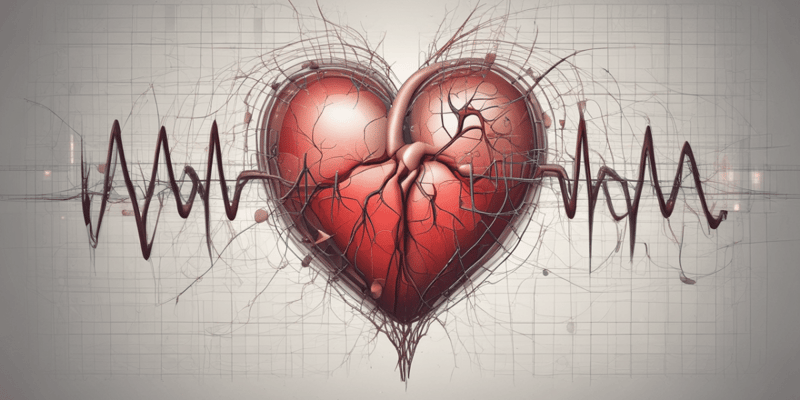Podcast
Questions and Answers
What is the characteristic feature of biphasic truncated technology in defibrillation?
Which of the following is NOT a safety measure to take before defibrillation?
How does monophasic sinusoidal technology primarily differ from biphasic truncated technology?
What is the approximate success rate of monophasic sinusoidal technology for defibrillation?
Signup and view all the answers
Which safety measure should be observed during defibrillation?
Signup and view all the answers
What is the recommended diameter for external paddle electrodes used on infants?
Signup and view all the answers
Which safety measure is essential before using external paddle electrodes?
Signup and view all the answers
What should be done during the defibrillation process to ensure safety?
Signup and view all the answers
Which of the following actions must be taken after using the defibrillator?
Signup and view all the answers
In the case of a diaphoretic patient, what is the recommended action before defibrillation?
Signup and view all the answers
Study Notes
Pulseless Ventricular Tachycardia
- Pulseless ventricular tachycardia (VT) is a life-threatening cardiac rhythm that results in no blood flow.
- This is because the ventricles are contracting too rapidly and ineffectively.
Defibrillation
- Defibrillation is a medical procedure used to treat life-threatening cardiac arrhythmias like ventricular fibrillation (VF) and pulseless VT.
- It involves delivering a controlled electrical shock to the heart to reset its rhythm.
Types of Defibrillation Technologies
- Monophasic Defibrillation: Uses a single current flow (older technology, requires higher joules)
- Biphasic Defibrillation: Uses bi-directional current flow (more efficient, requires lower joules)
Comparing Defibrillation Technologies
- Monophasic technology is often found in older defibrillators and requires a higher energy level (200-360 joules)
- Biphasic technology is more effective and safe, requiring a lower energy level (150-200 joules). This is also the preferred type of defibrillation technology.
- Success rates are generally higher with biphasic defibrillation, showing significant improvement over the older monophasic technology.
General Defibrillation Safety Measures
-
Before Defibrillation:
- Remove any metallic objects
- Remove transdermal patches
- Remove hair from the defibrillation sites
- Avoid applying alcohol to the skin prior to defibrillation
- Use appropriate size defibrillation pads
- Use appropriate amount of gel on the pads
- Ensure a dry patient environment
-
During Defibrillation:
- Stay away from the patient
- Maintain a dry patient environment and procedure
American Heart Association Guidelines for External Paddle Electrode Size
- Infant (4 to 5 cm)
- Child (8 cm)
- Adult (optimal size unknown, typically 13 cm)
Safety Measures During Defibrillation
- Ensure good contact between the paddles and the patient's chest.
- Provide adequate oxygenation to the patient
- Ensure the defibrillator has enough battery life.
- Do not discharge the defibrillator until firm pressure is applied to both paddles.
Special Considerations for Electrical Therapy
- Early defibrillation is a crucial factor in improving survival rates.
- If the patient's chest is wet or diaphoretic, dry the skin thoroughly before applying paddles or electrodes.
Direct Internal Defibrillation
- This procedure involves delivering an electric current directly to the surface of the myocardium.
- It is performed during open-chest procedures, such as open sternotomy or thoracotomy.
- Direct internal defibrillation is preferred for patients undergoing open heart surgery and in emergency thoracotomies.
- It requires lower energy levels compared to external defibrillation.
- Internal paddle placement is essential to ensure the heart's axis is between the current sources.
Direct Internal Defibrillation Complications
- Cardiopulmonary arrest or death.
- Cerebral anoxia and brain death.
- Respiratory complications (due to decreased oxygenation)
- Burns (due to the electrical energy used)
Internal Paddle Electrode Diameter Recommendations
- Infant: 2.8 cm
- Child: 4.5 cm
- Adult: 6 or 7.5 cm
Implantable Cardioverter-Defibrillators (ICDs)
- An implanted device that monitors the heart's rhythm and provides a shock when necessary.
- It plays a vital role in treating life-threatening ventricular dysrhythmias.
Purposes of ICDs
- Continuously monitor the patient's rhythm
- Detect rhythm changes
- Deliver a shock to correct life-threatening dysrhythmias
Indications for ICDs
- Survivors of cardiac arrest due to ventricular fibrillation (VF) or ventricular tachycardia (VT).
- Spontaneous sustained VT associated with structural heart disease.
- Syncope of undetermined origin with a history of induced VT or VF.
- Left ventricular dysfunction with an ejection fraction (EF) less than 35% due to prior myocardial infarction (MI).
- Non-ischemic dilated cardiomyopathy (ND-CM) with an EF less than or equal to 35%.
Cardioversion
- A therapy used to terminate hemodynamically unstable tachydysrhythmias.
- Cardioversion works by delivering a synchronized electrical shock to reset the heart's rhythm.
Purposes of Cardioversion
- Convert tachydysrhythmias that are a risk to the patient's hemodynamic status.
- Prevent the development of ventricular fibrillation when the patient is experiencing unstable ventricular tachycardia with a pulse.
Indications for Cardioversion
- Unstable atrial tachycardia
- Atrial fibrillation
- Atrial flutter
- Ventricular tachycardia with a pulse
Types of Cardioversion
- Chemical cardioversion: Using antiarrhythmic medications to restore normal rhythm.
- Electrical cardioversion: (also known as direct current (DC) cardioversion) delivers a synchronized electrical shock.
Cardioversion Complications
- Continued tachydysrhythmias despite cardioversion.
- Ventricular fibrillation progressing to cardiopulmonary arrest
- Pulmonary or cerebral emboli
- Respiratory complications and hypotension
- Paddle burns
Cardioversion Assessment
- Chart review: Assess ECG for tachydysrhythmias and lab values for potassium, magnesium, and calcium levels.
- Patient assessment: Observe vital signs and monitor the ECG for any changes in rhythm.
- Machine assessment: Ensure the cardioversion machine is set up correctly and functioning properly.
Studying That Suits You
Use AI to generate personalized quizzes and flashcards to suit your learning preferences.
Description
Explore the critical concepts of pulseless ventricular tachycardia and the various defibrillation technologies used to treat this life-threatening condition. This quiz covers the differences between monophasic and biphasic defibrillation and their effectiveness. Test your knowledge on how to manage cardiac rhythms and the technology behind defibrillation.




